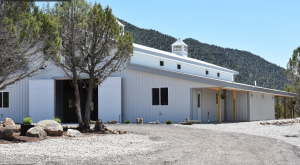The following is the second part of a two part series on the risk of a metal roof and lightning. Jump back one day to read the first segment.
Jim Cunningham writes:
“Lightning – like any electrical charge – seeks the path of least resistance to discharge. In CG lightning, it’s discharging into the earth, but it has to move through an expanse of air to get there. Trees and buildings are better electrical conductors than air. A tall building provides an easier path by shortening the distance that lightning has to travel through air. Accordingly, in the general location where the lightning discharges, it will seek the best conductor that is closest to the cloud. A tall tree is more likely to be hit than the short tree next to it. A tall or large building is more likely to be hit than a small, short one. Roof covering material, or other structural materials of the building, are not determinant factors of where it will strike, the placement and size of the building are.
 The consequences of the strike, however, depend a great deal on what the building is made of, and whether or not it has a lightning protection system. Electricity passes more easily through a good conductor such as copper or steel than it does through a poor conductor such as wood or concrete. The poor conductor has more electrical resistance, which converts some of the lightning’s tremendous electrical energy into heat, possibly causing fires or explosions.”
The consequences of the strike, however, depend a great deal on what the building is made of, and whether or not it has a lightning protection system. Electricity passes more easily through a good conductor such as copper or steel than it does through a poor conductor such as wood or concrete. The poor conductor has more electrical resistance, which converts some of the lightning’s tremendous electrical energy into heat, possibly causing fires or explosions.”
“A conductive metal roof….. gives lightning a low-resistance path to the earth. A metal building may survive a lightning strike with less damage than a similarly sized and located building made of higher-resistance materials. This result is rather counter-intuitive, but it is similar to the fact that during a lightning storm you are safer inside a car – with its metal body – than you are standing next to the car.
The actual danger to human life or to property during a lightning strike depends greatly on whether or not the building is occupied, whether it is made of combustible materials, and whether it contains combustible materials. Electronic equipment may be sensitive to the electrical discharge, and therefore is also at risk. Once again, a metal building system, with its non-combustible steel construction, may pose lower risk than a building made of combustible materials.
A lightning protection system gives electrical discharges an easy path to the earth, usually routing it around the outside of the structure. At its most basic, it consists of a metal lightning rod placed so that it is the tallest part of a building, and connected by metal wires to metal rods buried in the earth. (Telecommunications towers, which by design are usually the tallest structures in their immediate surroundings, are often protected by grounding them to a buried ring of copper an inch or more thick, and completely surrounding the tower in a circle several hundred feet across.) A professionally designed lightning protection system may be desirable for buildings whose size and location make lightning strikes more likely, or whose structure and/or contents might be vulnerable to the effects of lighting. If the presence of a metal roof raises the awareness of the need for lightning protection, that might be considered another benefit of metal roofing.”
And there you have it folks, the safety of being inside a steel covered pole building when lightning strikes. It’s good to know I am safer inside my steel covered pole building home than outside. Safe and warm.






